Prediction and Influencing Factors of Precipitation in the Songliao River Basin, China: Insights from CMIP6
Abstract
1. Introduction
2. Literature Review
3. Study Area, Data, and Methods
3.1. Description of Songliao River Basin
3.2. Data
3.2.1. Observation Data
3.2.2. Simulation and Prediction Data
3.2.3. Geographical Factors Data
3.3. Methods
3.3.1. CMIP6 GCMs Data Processing
3.3.2. Comprehensive Evaluation of CMIP6 GCMs
3.3.3. Weighted Multi-Model Ensemble Average
3.3.4. Bias Correction
3.3.5. Characteristic Analysis of Precipitation
4. Results
4.1. Climatological Characteristics of Observed Precipitation
4.2. Evaluation of CMIP6 GCMs on the Precipitation in the Songliao River Basin
4.2.1. Evaluation Based on Spatiotemporal Characteristics
4.2.2. Comprehensive Evaluation and Multi-Model Ensemble Average
4.2.3. Bias Correction for MME2
4.3. Future Prediction of Precipitation in Songliao River Basin from 2026 to 2100
4.3.1. Temporal Evolution of Precipitation
4.3.2. Spatial Change Pattern of Precipitation
4.4. Factors Influencing Precipitation in the Songliao River Basin
4.4.1. Geographical Factors
4.4.2. Temperature Rise Factors
5. Discussion
5.1. Analysis of CMIP6 GCMs’ Simulation Effect
5.2. Precipitation Characteristics and Potential Influencing Factors
5.3. Limitations and Future Prospects
6. Conclusions
Author Contributions
Funding
Institutional Review Board Statement
Informed Consent Statement
Data Availability Statement
Conflicts of Interest
References
- Huang, J.P.; Yu, H.P.; Han, D.L.; Zhang, G.L.; Wei, Y.; Huang, J.P.; An, L.L.; Liu, X.Y.; Ren, Y. Declines in global ecological security under climate change. Ecol. Indic. 2020, 117, 106651. [Google Scholar] [CrossRef]
- Beard, S.J.; Holt, L.; Tzachor, A.; Kemp, L.; Avin, S.; Torres, P.; Belfield, H. Assessing climate change's contribution to global catastrophic risk. Futures 2021, 127, 102673. [Google Scholar] [CrossRef]
- Wu, S.H.; Liu, L.L.; Gao, J.B.; Wang, W.T. Integrate Risk From Climate Change in China Under Global Warming of 1.5 and 2.0 °C. Earths Future 2019, 7, 1307–1322. [Google Scholar] [CrossRef]
- Sun, B.; Xue, R.F.; Li, W.L.; Zhou, S.Y.; Li, H.X.; Zhou, B.T.; Wang, H.J. How does Mei-yu precipitation respond to climate change? Natl. Sci. Rev. 2023, 10, nwad246. [Google Scholar] [CrossRef]
- Li, W.Y.; He, X.G.; Scaioni, M.; Yao, D.J.; Mi, C.R.; Zhao, J.; Chen, Y.; Zhang, K.H.; Gao, J.; Li, X. Annual precipitation and daily extreme precipitation distribution: Possible trends from 1960 to 2010 in urban areas of China. Geomat. Nat. Hazards Risk 2019, 10, 1694–1711. [Google Scholar] [CrossRef]
- Jiang, X.L.; Zhang, L.P.; Liang, Z.M.; Fu, X.L.; Wang, J.; Xu, J.X.; Zhang, Y.C.; Zhong, Q. Study of early flood warning based on postprocessed predicted precipitation and Xinanjiang model. Weather Clim. Extrem. 2023, 42, 100611. [Google Scholar] [CrossRef]
- Wang, L.; Zhang, F.; Fu, S.H.; Shi, X.N.; Chen, Y.; Jagirani, M.D.; Zeng, C. Assessment of soil erosion risk and its response to climate change in the mid-Yarlung Tsangpo River region. Environ. Sci. Pollut. Res. 2020, 27, 607–621. [Google Scholar] [CrossRef]
- Wang, L.L.; Cherkauer, K.A.; Flanagan, D.C. Impacts of Climate Change on Soil Erosion in the Great Lakes Region. Water 2018, 10, 715. [Google Scholar] [CrossRef]
- Tang, X.G.; Wang, L.J.; Wang, H.Y.; Yuan, Y.D.; Huang, D.; Zhang, J.C. Predicted Climate Change will Increase Landslide Risk in Hanjiang River Basin, China. J. Earth Sci. 2024, 35, 1334–1354. [Google Scholar] [CrossRef]
- Dijk, V.A.I.J.M.; Beck, H.E.; Boergens, E.; Jeu, R.A.M.d.; Dorigo, W.A.; Edirisinghe, C.; Forootan, E.; Guo, E.; Güntner, A.; Hou, J.; et al. Global Water Monitor 2024, Summary Report. 2025. Available online: https://knowledge4policy.ec.europa.eu/publication/global-water-monitor-2024-summary-report_en (accessed on 11 February 2025).
- Touzé-Peiffer, L.; Barberousse, A.; Le Treut, H. The Coupled Model Intercomparison Project: History, uses, and structural effects on climate research. Wiley Interdiscip. Rev.-Clim. Change 2020, 11, e648. [Google Scholar] [CrossRef]
- Zhou, T.J.; Zou, L.W.; Wu, B.; Jin, C.X.; Song, F.F.; Chen, X.L.; Zhang, L.X. Development of earth/climate system models in China: A review from the Coupled Model Intercomparison Project perspective. J. Meteorol. Res. 2014, 28, 762–779. [Google Scholar] [CrossRef]
- Eyring, V.; Bony, S.; Meehl, G.A.; Senior, C.A.; Stevens, B.; Stouffer, R.J.; Taylor, K.E. Overview of the Coupled Model Intercomparison Project Phase 6 (CMIP6) experimental design and organization. Geosci. Model Dev. 2016, 9, 1937–1958. [Google Scholar] [CrossRef]
- Tebaldi, C.; Debeire, K.; Eyring, V.; Fischer, E.; Fyfe, J.; Friedlingstein, P.; Knutti, R.; Lowe, J.; O'Neill, B.; Sanderson, B.; et al. Climate model projections from the Scenario Model Intercomparison Project (ScenarioMIP) of CMIP6. Earth Syst. Dyn. 2021, 12, 253–293. [Google Scholar] [CrossRef]
- Xin, X.G.; Wu, T.W.; Zheng, M.Z.; Fang, Y.J.; Lu, Y.X.; Zhang, J. Decadal prediction of Northeast Asian winter precipitation with CMIP6 models. Clim. Dyn. 2023, 62, 3245–3259. [Google Scholar] [CrossRef]
- Song, X.Y.; Xu, M.; Kang, S.C.; Wang, R.J.; Wu, H. Evaluation and projection of changes in temperature and precipitation over Northwest China based on CMIP6 models. Int. J. Climatol. 2024, 44, 5039–5056. [Google Scholar] [CrossRef]
- Du, Y.; Wang, D.G.; Zhu, J.X.; Wang, D.Y.; Qi, X.X.; Cai, J.H. Comprehensive assessment of CMIP5 and CMIP6 models in simulating and projecting precipitation over the global land. Int. J. Climatol. 2022, 42, 6859–6875. [Google Scholar] [CrossRef]
- Li, Z.Y.; Liu, T.; Huang, Y.; Peng, J.B.; Ling, Y.A. Evaluation of the CMIP6 Precipitation Simulations Over Global Land. Earths Future 2022, 10, e2021EF002500. [Google Scholar] [CrossRef]
- Palmer, T.E.; Booth, B.B.B.; McSweeney, C.F. How does the CMIP6 ensemble change the picture for European climate projections? Environ. Res. Lett. 2021, 16, 094042. [Google Scholar] [CrossRef]
- Lou, D.; Berghuijs, W.R.; Ullah, W.; Zhu, B.Y.; Shi, D.W.; Hu, Y.; Li, C.; Ullah, S.; Zhou, H.; Chai, Y.F.; et al. Uncertainty reduction for precipitation prediction in North America. PLoS ONE 2024, 19, e0301759. [Google Scholar] [CrossRef]
- Almazroui, M.; Saeed, F.; Saeed, S.; Islam, M.N.; Ismail, M.; Klutse, N.A.B.; Siddiqui, M.H. Projected Change in Temperature and Precipitation Over Africa from CMIP6. Earth Syst. Environ. 2020, 4, 455–475. [Google Scholar] [CrossRef]
- Hua, L.J.; Zhao, T.B.; Zhong, L.H. Future changes in drought over Central Asia under CMIP6 forcing scenarios. J. Hydrol. Reg. Stud. 2022, 43, 101191. [Google Scholar] [CrossRef]
- Pimonsree, S.; Kamworapan, S.; Gheewala, S.H.; Thongbhakdi, A.; Prueksakorn, K. Evaluation of CMIP6 GCMs performance to simulate precipitation over Southeast Asia. Atmos. Res. 2023, 282, 106522. [Google Scholar] [CrossRef]
- Jia, Q.M.; Jia, H.F.; Li, Y.J.; Yin, I.K. Applicability of CMIP5 and CMIP6 Models in China: Reproducibility of Historical Simulation and Uncertainty of Future Projection. J. Clim. 2023, 36, 5809–5824. [Google Scholar] [CrossRef]
- Lu, K.D.; Arshad, M.; Ma, X.Y.; Ullah, I.; Wang, J.J.; Shao, W. Evaluating observed and future spatiotemporal changes in precipitation and temperature across China based on CMIP6-GCMs. Int. J. Climatol. 2022, 42, 7703–7729. [Google Scholar] [CrossRef]
- Tian, J.X.; Zhang, Z.X.; Ahmed, Z.; Zhang, L.Y.; Su, B.D.; Tao, H.; Jiang, T. Projections of precipitation over China based on CMIP6 models. Stoch. Environ. Res. Risk Assess. 2021, 35, 831–848. [Google Scholar] [CrossRef]
- Chen, R.; Duan, K.Q.; Shang, W.; Shi, P.H.; Meng, Y.L.; Zhang, Z.P. Increase in seasonal precipitation over the Tibetan Plateau in the 21st century projected using CMIP6 models. Atmos. Res. 2022, 277, 106306. [Google Scholar] [CrossRef]
- Pan, H.; Jin, Y.J.; Zhu, X.C. Comparison of Projections of Precipitation over Yangtze River Basin of China by Different Climate Models. Water 2022, 14, 1888. [Google Scholar] [CrossRef]
- He, A.; Wang, C.; Xu, L.; Wang, P.; Wang, W.; Chen, N.C.; Chen, Z.Q. An evaluation of statistical and deep learning-based correction of monthly precipitation over the Yangtze River basin in China based on CMIP6 GCMs. Environ. Dev. Sustain. 2024. [Google Scholar] [CrossRef]
- Sun, Z.L.; Liu, Y.L.; Zhang, J.Y.; Chen, H.; Shu, Z.K.; Chen, X.; Jin, J.L.; Guan, T.S.; Liu, C.S.; He, R.M.; et al. Projecting Future Precipitation in the Yellow River Basin Based on CMIP6 Models. J. Appl. Meteorol. Climatol. 2022, 61, 1399–1417. [Google Scholar] [CrossRef]
- Kulkarni, A.; Raju, P.V.S.; Ashrit, R.; Sagalgile, A.; Singh, B.B.; Prasad, J. Optimization of CMIP6 models for simulation of summer monsoon rainfall over India by analysis of variance. Q. J. R. Meteorol. Soc. 2024, 150, 3274–3289. [Google Scholar] [CrossRef]
- Ge, F.; Zhu, S.P.; Luo, H.L.; Zhi, X.F.; Wang, H. Future changes in precipitation extremes over Southeast Asia: Insights from CMIP6 multi-model ensemble. Environ. Res. Lett. 2021, 16, 024013. [Google Scholar] [CrossRef]
- Babaousmail, H.; Hou, R.T.; Ayugi, B.; Ojara, M.; Ngoma, H.; Karim, R.; Rajasekar, A.; Ongoma, V. Evaluation of the Performance of CMIP6 Models in Reproducing Rainfall Patterns over North Africa. Atmosphere 2021, 12, 475. [Google Scholar] [CrossRef]
- Zhu, C.R.; Yue, Q.; Huang, J.Q. Projections of Mean and Extreme Precipitation Using the CMIP6 Model: A Study of the Yangtze River Basin in China. Water 2023, 15, 3043. [Google Scholar] [CrossRef]
- Xu, H.W.; Chen, H.P.; Wang, H.J. Future changes in precipitation extremes across China based on CMIP6 models. Int. J. Climatol. 2022, 42, 635–651. [Google Scholar] [CrossRef]
- Sun, Z.L.; Liu, Y.L.; Chen, H.; Zhang, J.Y.; Jin, J.L.; Bao, Z.X.; Wang, G.Q.; Tang, L.S. Evaluation of future climatology and its uncertainty under SSP scenarios based on a bias processing procedure: A case study of the Lancang-Mekong River Basin. Atmos. Res. 2024, 298, 107134. [Google Scholar] [CrossRef]
- Yan, Y.L.; Wang, H.; Li, G.P.; Xia, J.; Ge, F.; Zeng, Q.Y.; Ren, X.Y.; Tan, L.Y. Projection of Future Extreme Precipitation in China Based on the CMIP6 from a Machine Learning Perspective. Remote Sens. 2022, 14, 4033. [Google Scholar] [CrossRef]
- Babiker, W.; Tan, G.R.; Alriah, M.A.A.; Elameen, A.M. Evaluation and Correction Analysis of the Regional Rainfall Simulation by CMIP6 over Sudan. Geogr. Pannonica 2023, 28, 53–70. [Google Scholar] [CrossRef]
- Oruc, S. Performance of bias corrected monthly CMIP6 climate projections with different reference period data in Turkey. Acta Geophys. 2022, 70, 777–789. [Google Scholar] [CrossRef]
- Liu, W.C.; Zhang, Q.; Fu, Z.; Chen, X.Y.; Li, H. Analysis and Estimation of Geographical and Topographic Influencing Factors for Precipitation Distribution over Complex Terrains: A Case of the Northeast Slope of the Qinghai-Tibet Plateau. Atmosphere 2018, 9, 349. [Google Scholar] [CrossRef]
- Zhou, M.Z.; Zhou, G.S.; Lv, X.M.; Zhou, L.; Ji, Y.H. Global warming from 1.5 to 2 °C will lead to increase in precipitation intensity in China. Int. J. Climatol. 2019, 39, 2351–2361. [Google Scholar] [CrossRef]
- Mishra, A.K. Quantifying the impact of global warming on precipitation patterns in India. Meteorol. Appl. 2019, 26, 153–160. [Google Scholar] [CrossRef]
- Nojarov, P. Circulation factors affecting precipitation over Bulgaria. Theor. Appl. Climatol. 2017, 127, 87–101. [Google Scholar] [CrossRef]
- Wei, F.L.; Liu, D.H.; Liang, Z.; Wang, Y.Y.; Shen, J.S.; Wang, H.; Zhang, Y.J.; Wang, Y.X.; Li, S.C. Spatial heterogeneity and impact scales of driving factors of precipitation changes in the Beijing-Tianjin-Hebei region, China. Front. Environ. Sci. 2023, 11, 1161106. [Google Scholar] [CrossRef]
- Siabi, E.K.; Awafo, E.A.; Kabo-bah, A.T.; Derkyi, N.S.A.; Akpoti, K.; Mortey, E.M.; Yazdanie, M. Assessment of Shared Socioeconomic Pathway (SSP) climate scenarios and its impacts on the Greater Accra region. Urban Clim. 2023, 49, 101432. [Google Scholar] [CrossRef]
- Wang, X.H.; Cong, P.T.; Jin, Y.H.; Jia, X.C.; Wang, J.S.; Han, Y.X. Assessing the Effects of Land Cover Land Use Change on Precipitation Dynamics in Guangdong-Hong Kong-Macao Greater Bay Area from 2001 to 2019. Remote Sens. 2021, 13, 1135. [Google Scholar] [CrossRef]
- Wang, C. Anthropogenic aerosols and the distribution of past large-scale precipitation change. Geophys. Res. Lett. 2015, 42, 10876–10884. [Google Scholar] [CrossRef]
- Xi, Z.; Yang, X.; Liu, Y.; Ji, L.; Rao, W. Characteristics of Extreme Precipitation Change from 1961 to 2017 in Songliao Basin. Res. Soil Water Conserv. 2019, 26, 199. [Google Scholar]
- Liang, F.; Liu, D.; Wang, W.; Liu, P.; Yu, F. Analysis on the Trend of Variation of Summer Precipitation in Northeast China During the Period from 1961 to 2013. Res. Soil Water Conserv. 2015, 22, 67–73. [Google Scholar]
- Li, Z.L.; Jiao, X.Z. Evaluation and projections of summer daily precipitation over Northeastern China in an optimal CMIP6 Multimodel Ensemble. Clim. Dyn. 2024, 62, 6235–6251. [Google Scholar] [CrossRef]
- Gao, X.; Jiang, S.; Wang, S.; Tian, L.; Zhou, M. The division of precipitation change and its regional characteristics in Northeast China during 1961-2014. Chin. J. Ecol. 2016, 35, 1301–1307. [Google Scholar]
- Xie, Z.J.; Fu, Y.Y.; He, H.S.; Wang, S.Q.; Wang, L.C.; Liu, C. Increases in extreme precipitation expected in Northeast China under continued global warming. Clim. Dyn. 2024, 62, 4943–4965. [Google Scholar] [CrossRef]
- Wang, L.P.; Wang, W.G.; Zhang, J.Z. Analysis on spatial and temporal distribution characteristics of precipitation processes over main river basin in China. J. Nat. Disasters 2018, 27, 161–173. [Google Scholar]
- Ji, L.L.; Liu, Z.Q.; Song, S.; Liu, Y.X. Spatiotemporal characteristics and risk assessment of rainstorm in the Songliao River Basin from 1961 to 2020. Meteorol. Disaster Prev. 2024, 31, 1–5. [Google Scholar]
- Wang, H.; Asefa, T. Enhanced performance of CMIP6 climate models in simulating historical precipitation in the Florida Peninsula. Int. J. Climatol. 2024, 44, 2758–2778. [Google Scholar] [CrossRef]
- Gobie, B.G.; Assamnew, A.D.; Habtemicheal, B.A.; Woldegiyorgis, T.A. Comparison of GCMs Under CMIP5 and CMIP6 in Reproducing Observed Precipitation in Ethiopia During Rainy Seasons. Earth Syst. Environ. 2024, 8, 265–279. [Google Scholar] [CrossRef]
- Almazroui, M.; Saeed, S.; Saeed, F.; Islam, M.N.; Ismail, M. Projections of Precipitation and Temperature over the South Asian Countries in CMIP6. Earth Syst. Environ. 2020, 4, 297–320. [Google Scholar] [CrossRef]
- Nashwan, M.S.; Shahid, S. Future precipitation changes in Egypt under the 1.5 and 2.0°C global warming goals using CMIP6 multimodel ensemble. Atmos. Res. 2022, 265, 105908. [Google Scholar] [CrossRef]
- Zuo, J.P.; Qian, C.C. Evaluation of historical and future precipitation changes in CMIP6 over the Tarim River Basin. Theor. Appl. Climatol. 2022, 150, 1659–1675. [Google Scholar] [CrossRef]
- Huo, L.T.; Sha, J.X.; Wang, B.X.; Li, G.Z.; Ma, Q.Q.; Ding, Y.B. Revelation and Projection of Historic and Future Precipitation Characteristics in the Haihe River Basin, China. Water 2023, 15, 3245. [Google Scholar] [CrossRef]
- Xiao, H.; Zhuo, Y.; Sun, H.; Pang, K.W.; An, Z.J. Evaluation and Projection of Climate Change in the Second Songhua River Basin Using CMIP6 Model Simulations. Atmosphere 2023, 14, 1429. [Google Scholar] [CrossRef]
- Chang, L.; Li, Y.; Zhang, K.Y.; Zhang, J.L.; Li, Y.F. Temporal and Spatial Variation in Vegetation and Its Influencing Factors in the Songliao River Basin, China. Land 2023, 12, 1692. [Google Scholar] [CrossRef]
- Hu, C.; Xia, J.; She, D.X.; Xu, C.Y.; Zhang, L.P.; Song, Z.H.; Zhao, L. A modified regional L-moment method for regional extreme precipitation frequency analysis in the Songliao River Basin of China. Atmos. Res. 2019, 230, 104629. [Google Scholar] [CrossRef]
- Wu, J.; Gao, X.J. A gridded daily observation dataset over China region and comparison with the other datasets. Chin. J. Geophys. 2013, 56, 1102–1111. [Google Scholar]
- Shukla, K.K.; Attada, R. CMIP6 models informed summer human thermal discomfort conditions in Indian regional hotspot. Sci. Rep. 2023, 13, 1–14. [Google Scholar] [CrossRef] [PubMed]
- Xue, J.Y.; Shan, H.X.; Liang, J.H.; Dong, C.M. Assessment and Projections of Marine Heatwaves in the Northwest Pacific Based on CMIP6 Models. Remote Sens. 2023, 15, 2957. [Google Scholar] [CrossRef]
- Taylor, K.E. Summarizing multiple aspects of model performance in a single diagram. J. Geophys. Res. Atmos. 2001, 106, 7183–7192. [Google Scholar] [CrossRef]
- Chen, W.L.; Jiang, Z.H.; Li, L. Probabilistic Projections of Climate Change over China under the SRES A1B Scenario Using 28 AOGCMs. J. Clim. 2011, 24, 4741–4756. [Google Scholar] [CrossRef]
- Araghi, A.; Adamowski, J.F. Assessment of 30 gridded precipitation datasets over different climates on a country scale. Earth Sci. Inform. 2024, 17, 1301–1313. [Google Scholar] [CrossRef]
- Rentachintala, L.; Gangireddy, M.R.M.; Mohapatra, P.K. Trends of extreme flows of the Krishna river at a barrage, India. Int. J. River Basin Manag. 2023, 21, 723–729. [Google Scholar] [CrossRef]
- Han, Y.; Tian, X.T. Significant increase in humidity since 2003 in Qinghai Province, China: Evidence from annual and seasonal precipitation. Environ. Monit. Assess. 2023, 195, 1–15. [Google Scholar] [CrossRef]
- Xu, F.; Jia, Y.W.; Niu, C.W.; Liu, J.J.; Hao, C.F. Changes in Annual, Seasonal and Monthly Climate and Its Impacts on Runoff in the Hutuo River Basin, China. Water 2018, 10, 278. [Google Scholar] [CrossRef]
- Ren, Z.K.; Zhao, H.R.; Shi, K.M.; Yang, G.L. Spatial and Temporal Variations of the Precipitation Structure in Jiangsu Province from 1960 to 2020 and Its Potential Climate-Driving Factors. Water 2023, 15, 4032. [Google Scholar] [CrossRef]
- Du, J.; Zhou, L.; Yu, X.J.; Ding, Y.B.; Zhang, Y.K.; Wu, L.L.; Ao, T.Q. Understanding precipitation concentration changes, driving factors, and responses to global warming across mainland China. J. Hydrol. 2024, 645, 132164. [Google Scholar] [CrossRef]
- Tang, B.; Hu, W.T.; Duan, A.M. Assessment of Extreme Precipitation Indices over Indochina and South China in CMIP6 Models. J. Clim. 2021, 34, 7507–7524. [Google Scholar] [CrossRef]
- Luo, N.; Guo, Y. Impact of Model Resolution on the Simulation of Precipitation Extremes over China. Sustainability 2022, 14, 25. [Google Scholar] [CrossRef]
- Wang, L.; Zhang, J.Y.; Shu, Z.K.; Wang, Y.; Bao, Z.X.; Liu, C.S.; Zhou, X.; Wang, G.Q. Evaluation of the Ability of CMIP6 Global Climate Models to Simulate Precipitation in the Yellow River Basin, China. Front. Earth Sci. 2021, 9, 751974. [Google Scholar] [CrossRef]
- Yang, X.L.; Zhou, B.T.; Xu, Y.; Han, Z.Y. CMIP6 Evaluation and Projection of Temperature and Precipitation over China. Adv. Atmos. Sci. 2021, 38, 817–830. [Google Scholar] [CrossRef]
- He, M.F.; Chen, Y.B.; Sun, H.Z.; Liu, J. Projected Changes in Precipitation Based on the CMIP6 Optimal Multi-Model Ensemble in the Pearl River Basin, China. Remote Sens. 2023, 15, 4608. [Google Scholar] [CrossRef]
- Liu, J.; Wang, X.F.; Wu, D.Y.; Wang, X. The historical to future linkage of Arctic amplification on extreme precipitation over the Northern Hemisphere using CMIP5 and CMIP6 models. Adv. Clim. Change Res. 2024, 15, 573–583. [Google Scholar] [CrossRef]
- Qiu, D.X.; Wu, C.X.; Mu, X.M.; Zhao, G.J.; Gao, P. Changes in extreme precipitation in the Wei River Basin of China during 1957-2019 and potential driving factors. Theor. Appl. Climatol. 2022, 149, 915–929. [Google Scholar] [CrossRef]
- Du, H.; Xia, J.; Yan, Y.; Lu, Y.M.; Li, J.H. Spatiotemporal Variations of Extreme Precipitation in Wuling Mountain Area (China) and Their Connection to Potential Driving Factors. Sustainability 2022, 14, 8312. [Google Scholar] [CrossRef]
- Ham, Y.-G.; Kim, J.-H.; Min, S.-K.; Kim, D.; Li, T.; Timmermann, A.; Stuecker, M.F. Anthropogenic fingerprints in daily precipitation revealed by deep learning. Nature 2023, 622, 301–307. [Google Scholar] [CrossRef] [PubMed]
- Asadieh, B.; Krakauer, N.Y. Global trends in extreme precipitation: Climate models versus observations. Hydrol. Earth Syst. Sci. 2015, 19, 877–891. [Google Scholar] [CrossRef]
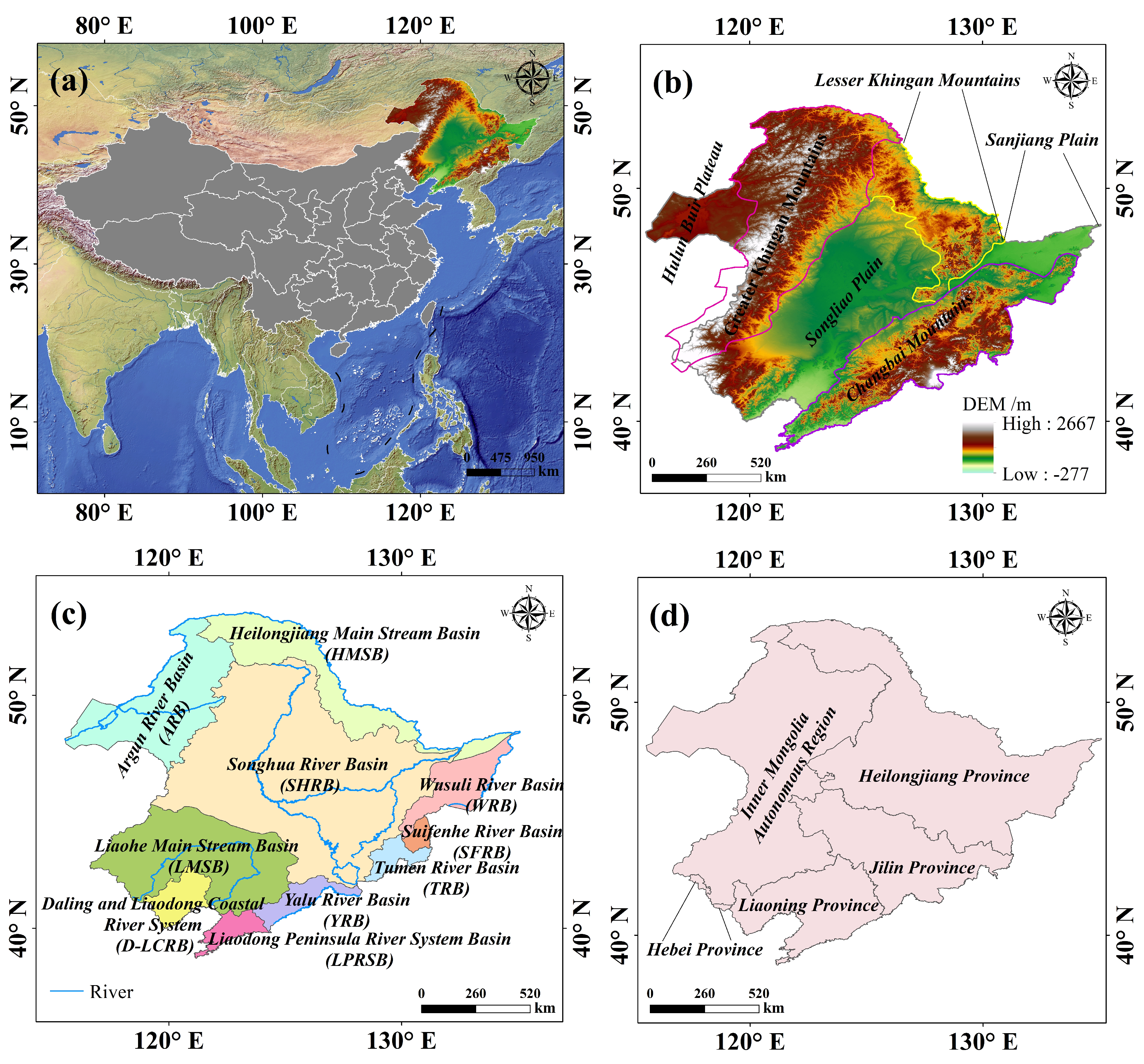
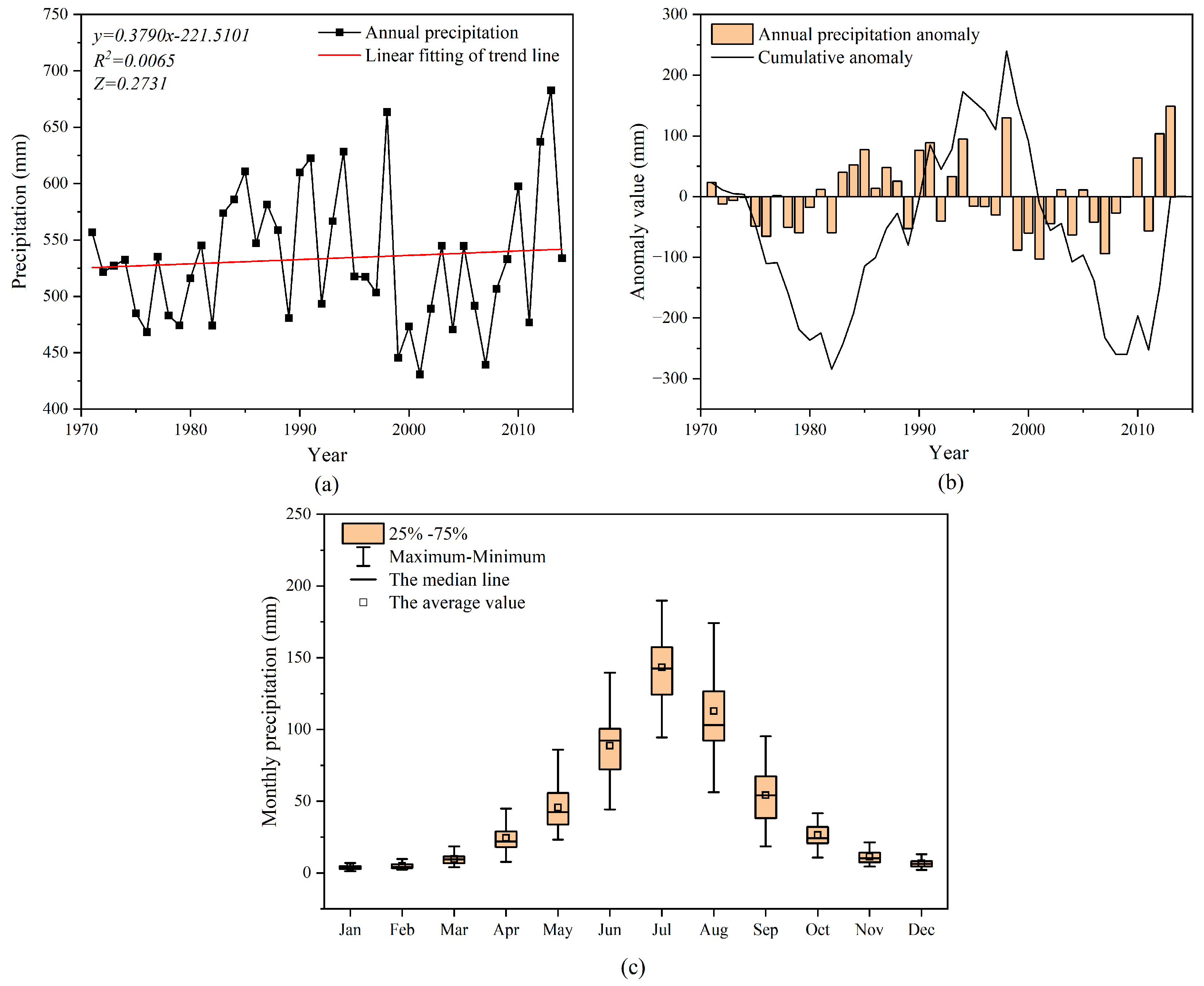
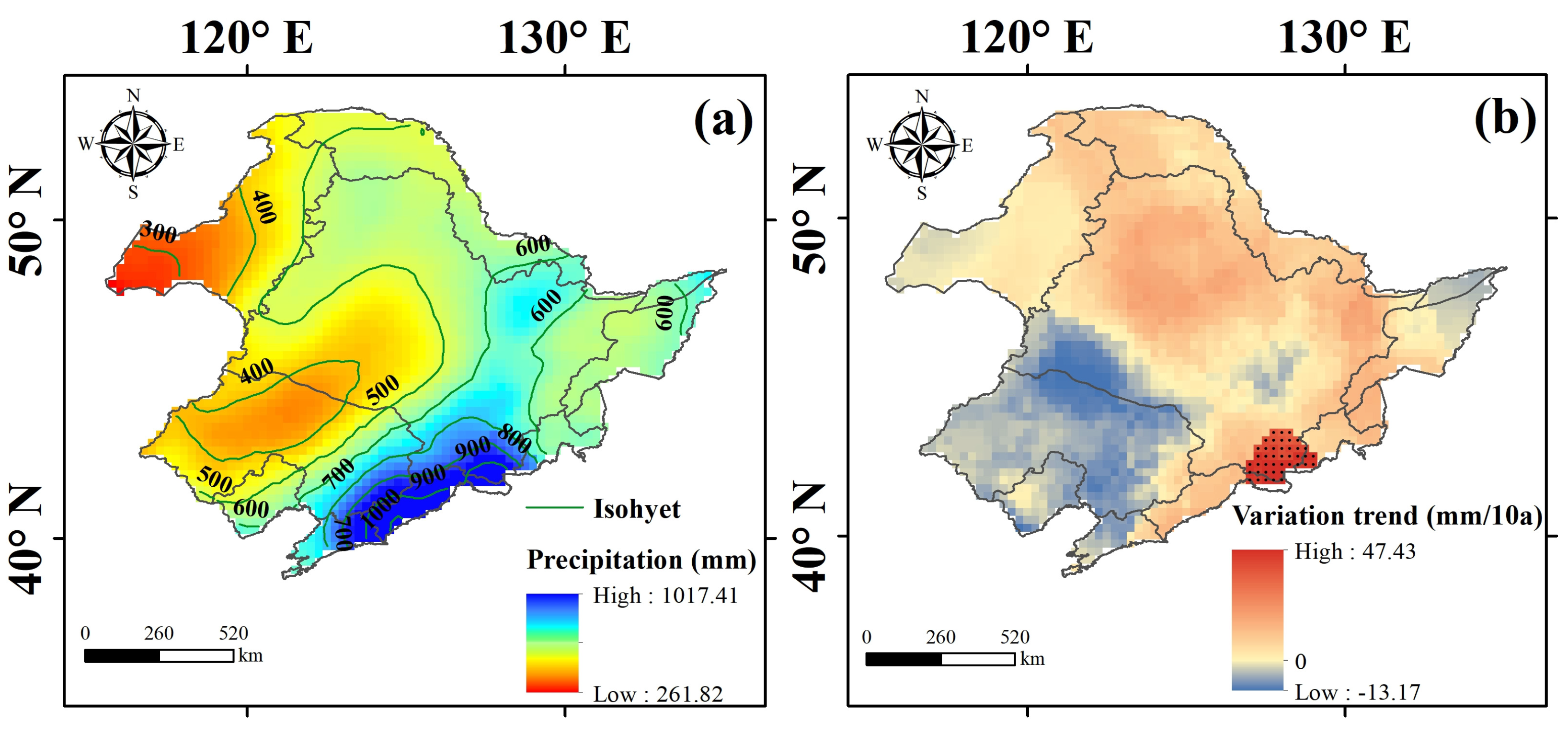


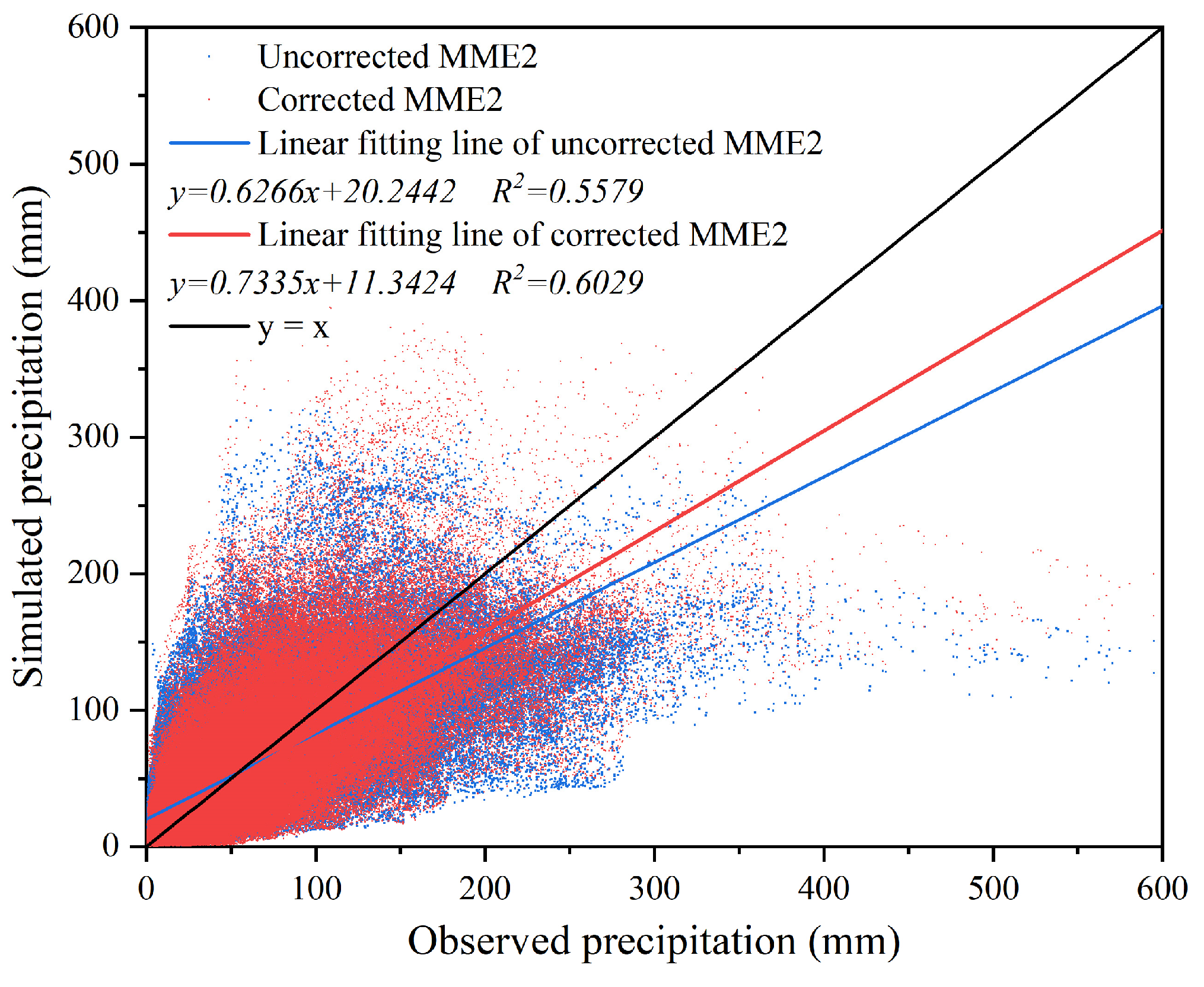

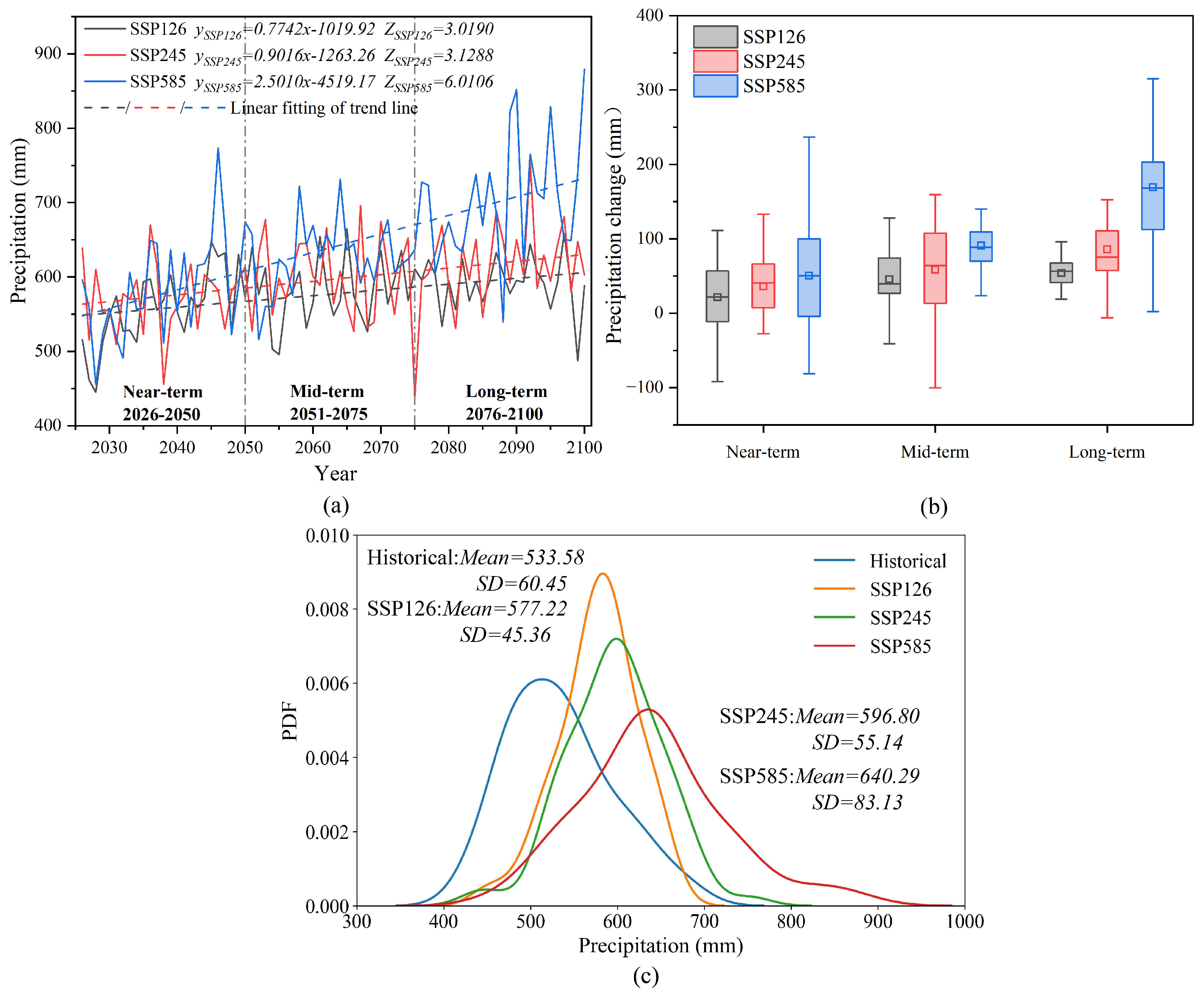


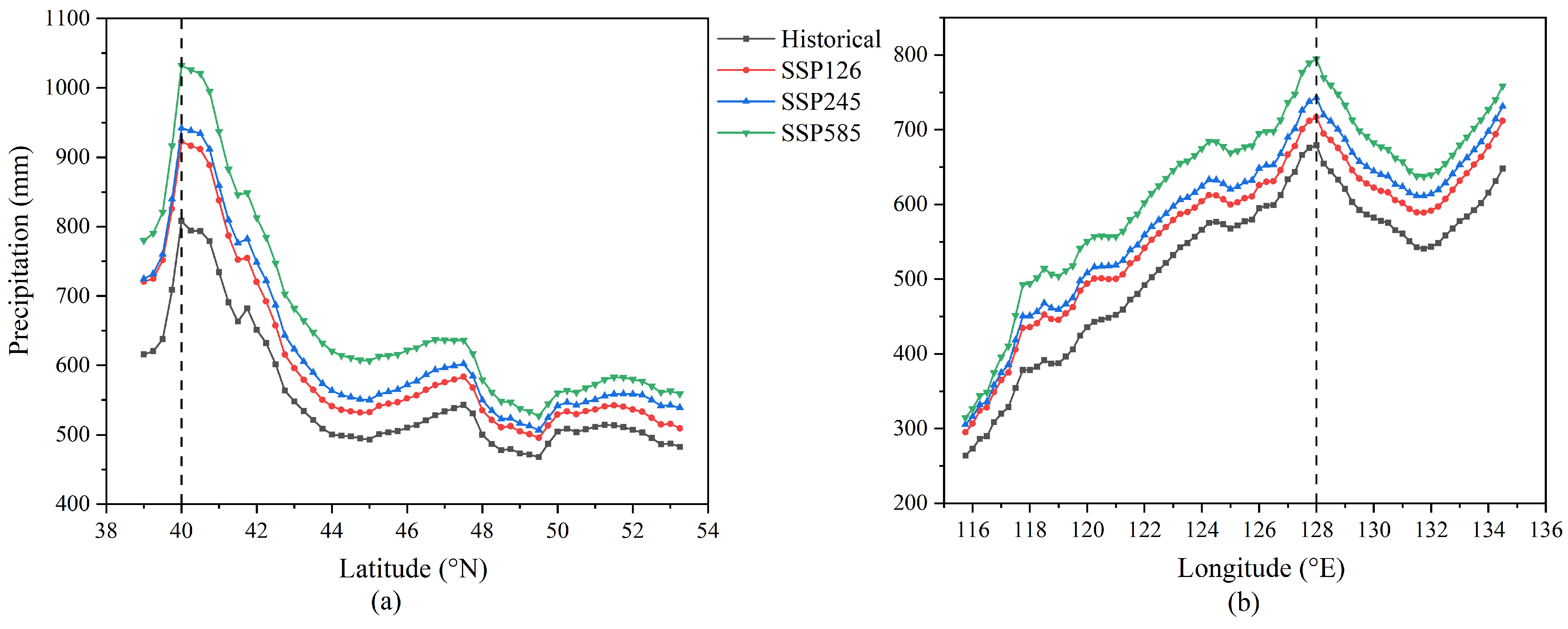
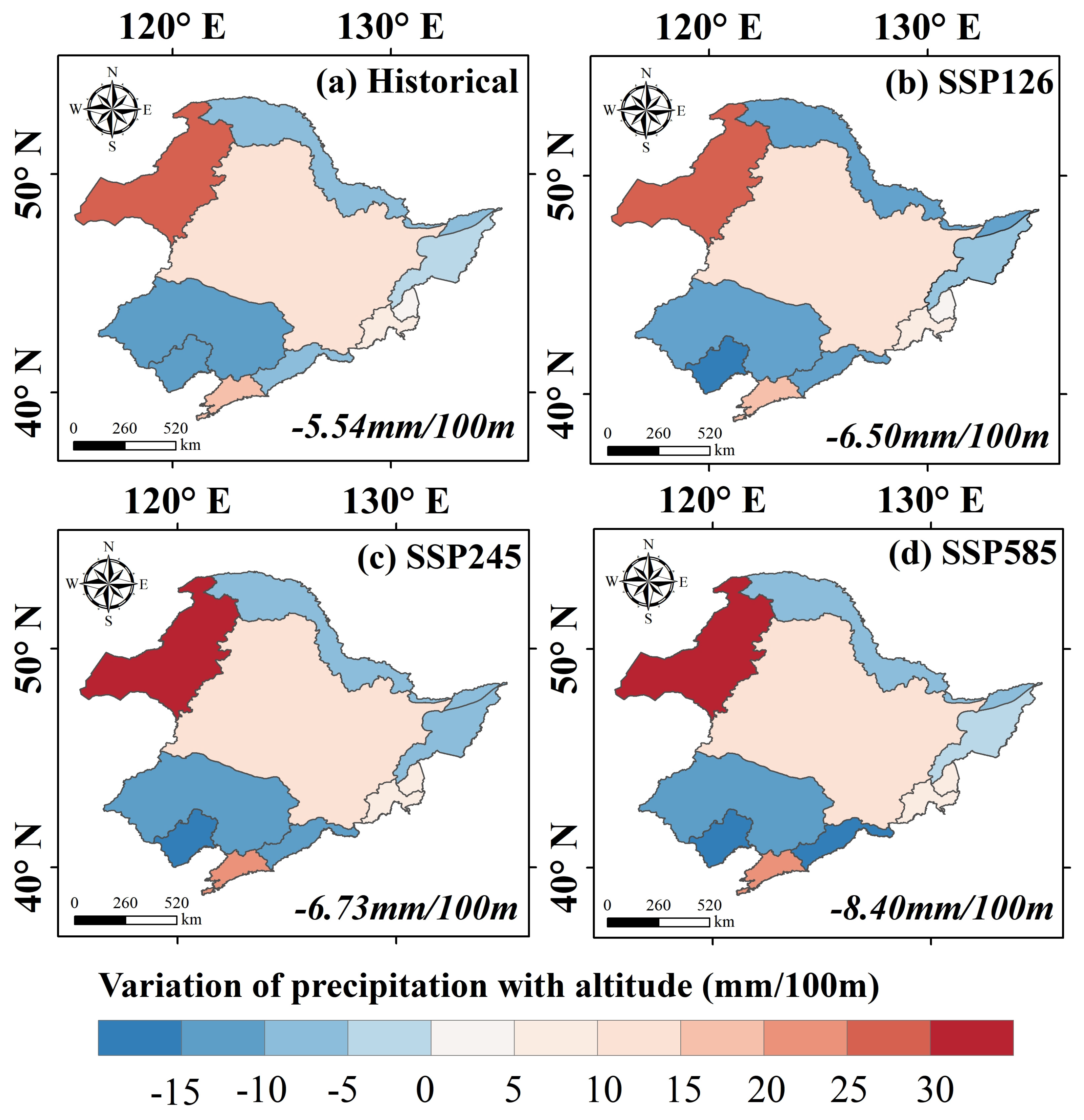


| Model | Institution ID | Country | Resolution (Longitude × Latitude) |
|---|---|---|---|
| ACCESS-CM2 | CSIRO | Australia | 1.875° × 1.25° |
| ACCESS-ESM1-5 | CSIRO | Australia | 1.875° × 1.25° |
| BCC-CSM2-MR | BCC | China | 1.125° × 1.125° |
| CanESM5 | CCCMA | Canada | 2.813° × 2.813° |
| CESM2-WACCM | NCAR | USA | 1.25° × 0.938° |
| CMCC-CM2-SR5 | CMCC | Italy | 1.25° × 0.938° |
| CMCC-ESM2 | CMCC | Italy | 1.25° × 0.938° |
| EC-Earth3 | EC-Earth-Consortium | Europe | 0.703° × 0.703° |
| EC-Earth3-Veg | EC-Earth-Consortium | Europe | 0.703° × 0.703° |
| EC-Earth3-Veg-LR | EC-Earth-Consortium | Europe | 1.125° × 1.125° |
| FGOALS-g3 | CAS | China | 2° × 2.25° |
| IITM-ESM | CCCR-IITM | India | 1.875° × 1.915° |
| INM-CM4-8 | INM | Russia | 2° × 1.5° |
| INM-CM5-0 | INM | Russia | 2° × 1.5° |
| IPSL-CM6A-LR | IPSL | France | 2.5° × 1.259° |
| MIROC6 | MIROC | Japan | 1.406° × 1.406° |
| MPI-ESM1-2-HR | MPI-M | Germany | 0.938° × 0.938° |
| MPI-ESM1-2-LR | MPI-M | Germany | 1.875° × 1.875° |
| MRI-ESM2-0 | MRI | Japan | 1.125° × 1.125° |
| NorESM2-LM | NCC | Norway | 2.5° × 1.875° |
| NorESM2-MM | NCC | Norway | 1.25° × 0.938° |
| TaiESM1 | AS-RCEC | China | 1.25° × 0.938° |
| Evaluation Feature | Specific Indicator |
|---|---|
| Mean | Mean annual precipitation (mean) |
| Time feature | Inter-annual variability skill (IVS) |
| Pearson correlation coefficient for intra-annual monthly precipitation (CCt) | |
| Trend variation | Significance statistic of Mann–Kendall trend test (Z) |
| Slope statistic of Mann–Kendall trend test (slope) | |
| Spatial feature | Pearson correlation coefficient for spatial characteristics (CCs) |
| Normalized root-mean-square error (NRMSE) | |
| Taylor skill score Ⅰ (TSS1) | |
| Taylor skill score Ⅱ (TSS2) |
| Model | Temporal Scale | Spatial Scale | |||||||
|---|---|---|---|---|---|---|---|---|---|
| Mean | IVS | CCt | Z | Slope | CCs | NRMSE | TSS1 | TSS2 | |
| CN05.1 | 533.578 | / | / | 0.273 | 0.226 | / | / | / | / |
| ACCESS-CM2 | 575.855 | 0.236 | 0.963 | 0.860 | 0.875 | 0.826 | 0.112 | 0.911 | 0.694 |
| ACCESS-ESM1-5 | 692.944 | 0.301 | 0.981 | −1.325 | −1.218 | 0.664 | 0.251 | 0.832 | 0.480 |
| BCC-CSM2-MR | 532.972 | 0.189 | 0.977 | 0.435 | 0.260 | 0.873 | 0.083 | 0.875 | 0.720 |
| CanESM5 | 604.875 | 0.324 | 0.987 | 0.010 | 0.026 | 0.603 | 0.193 | 0.773 | 0.399 |
| CESM2-WACCM | 690.223 | 0.701 | 0.993 | 1.446 | 1.609 | 0.839 | 0.239 | 0.862 | 0.671 |
| CMCC-CM2-SR5 | 793.744 | 0.602 | 0.991 | 1.487 | 1.507 | 0.735 | 0.365 | 0.868 | 0.567 |
| CMCC-ESM2 | 755.731 | 0.379 | 0.989 | 1.972 | 1.540 | 0.723 | 0.319 | 0.861 | 0.551 |
| EC-Earth3 | 610.007 | 0.182 | 0.989 | 2.761 | 2.411 | 0.921 | 0.132 | 0.918 | 0.815 |
| EC-Earth3-Veg | 632.757 | 0.145 | 0.990 | 0.273 | 0.335 | 0.922 | 0.155 | 0.922 | 0.820 |
| EC-Earth3-Veg-LR | 599.069 | 0.102 | 0.976 | 0.779 | 0.601 | 0.919 | 0.124 | 0.905 | 0.801 |
| FGOALS-g3 | 487.303 | 0.534 | 0.992 | 1.709 | 1.091 | 0.605 | 0.179 | 0.773 | 0.400 |
| IITM-ESM | 689.578 | 0.153 | 0.946 | 0.920 | 0.730 | 0.81 | 0.230 | 0.902 | 0.670 |
| INM-CM4-8 | 828.867 | 0.318 | 0.988 | 1.406 | 1.464 | 0.716 | 0.421 | 0.793 | 0.502 |
| INM-CM5-0 | 838.705 | 0.420 | 0.987 | −1.163 | −1.045 | 0.757 | 0.421 | 0.877 | 0.595 |
| IPSL-CM6A-LR | 729.119 | 0.279 | 0.976 | 1.507 | 1.367 | 0.816 | 0.302 | 0.759 | 0.569 |
| MIROC6 | 748.081 | 0.338 | 0.974 | 2.640 | 2.313 | 0.729 | 0.326 | 0.773 | 0.500 |
| MPI-ESM1-2-HR | 699.741 | 0.236 | 0.943 | −0.192 | −0.149 | 0.841 | 0.244 | 0.897 | 0.701 |
| MPI-ESM1-2-LR | 782.851 | 0.208 | 0.934 | −0.981 | −0.926 | 0.886 | 0.339 | 0.943 | 0.792 |
| MRI-ESM2-0 | 641.934 | 0.285 | 0.987 | −0.152 | −0.232 | 0.794 | 0.176 | 0.861 | 0.623 |
| NorESM2-LM | 609.174 | 0.256 | 0.989 | 0.111 | 0.108 | 0.874 | 0.131 | 0.864 | 0.711 |
| NorESM2-MM | 604.195 | 0.313 | 0.993 | 1.790 | 1.437 | 0.872 | 0.125 | 0.930 | 0.764 |
| TaiESM1 | 747.344 | 0.203 | 0.977 | −0.678 | −0.636 | 0.844 | 0.300 | 0.915 | 0.718 |
| Latitude | Longitude | Altitude | |
|---|---|---|---|
| Precipitation—historical | −0.746 a | 0.838 a | −0.136 a |
| Precipitation—SSP126 | −0.780 a | 0.854 a | −0.150 a |
| Precipitation—SSP245 | −0.777 a | 0.853 a | −0.150 a |
| Precipitation—SSP585 | −0.819 a | 0.811 a | −0.173 a |
Disclaimer/Publisher’s Note: The statements, opinions and data contained in all publications are solely those of the individual author(s) and contributor(s) and not of MDPI and/or the editor(s). MDPI and/or the editor(s) disclaim responsibility for any injury to people or property resulting from any ideas, methods, instructions or products referred to in the content. |
© 2025 by the authors. Licensee MDPI, Basel, Switzerland. This article is an open access article distributed under the terms and conditions of the Creative Commons Attribution (CC BY) license (https://creativecommons.org/licenses/by/4.0/).
Share and Cite
Yang, H.; Li, Z. Prediction and Influencing Factors of Precipitation in the Songliao River Basin, China: Insights from CMIP6. Sustainability 2025, 17, 2297. https://doi.org/10.3390/su17052297
Yang H, Li Z. Prediction and Influencing Factors of Precipitation in the Songliao River Basin, China: Insights from CMIP6. Sustainability. 2025; 17(5):2297. https://doi.org/10.3390/su17052297
Chicago/Turabian StyleYang, Hongnan, and Zhijun Li. 2025. "Prediction and Influencing Factors of Precipitation in the Songliao River Basin, China: Insights from CMIP6" Sustainability 17, no. 5: 2297. https://doi.org/10.3390/su17052297
APA StyleYang, H., & Li, Z. (2025). Prediction and Influencing Factors of Precipitation in the Songliao River Basin, China: Insights from CMIP6. Sustainability, 17(5), 2297. https://doi.org/10.3390/su17052297





